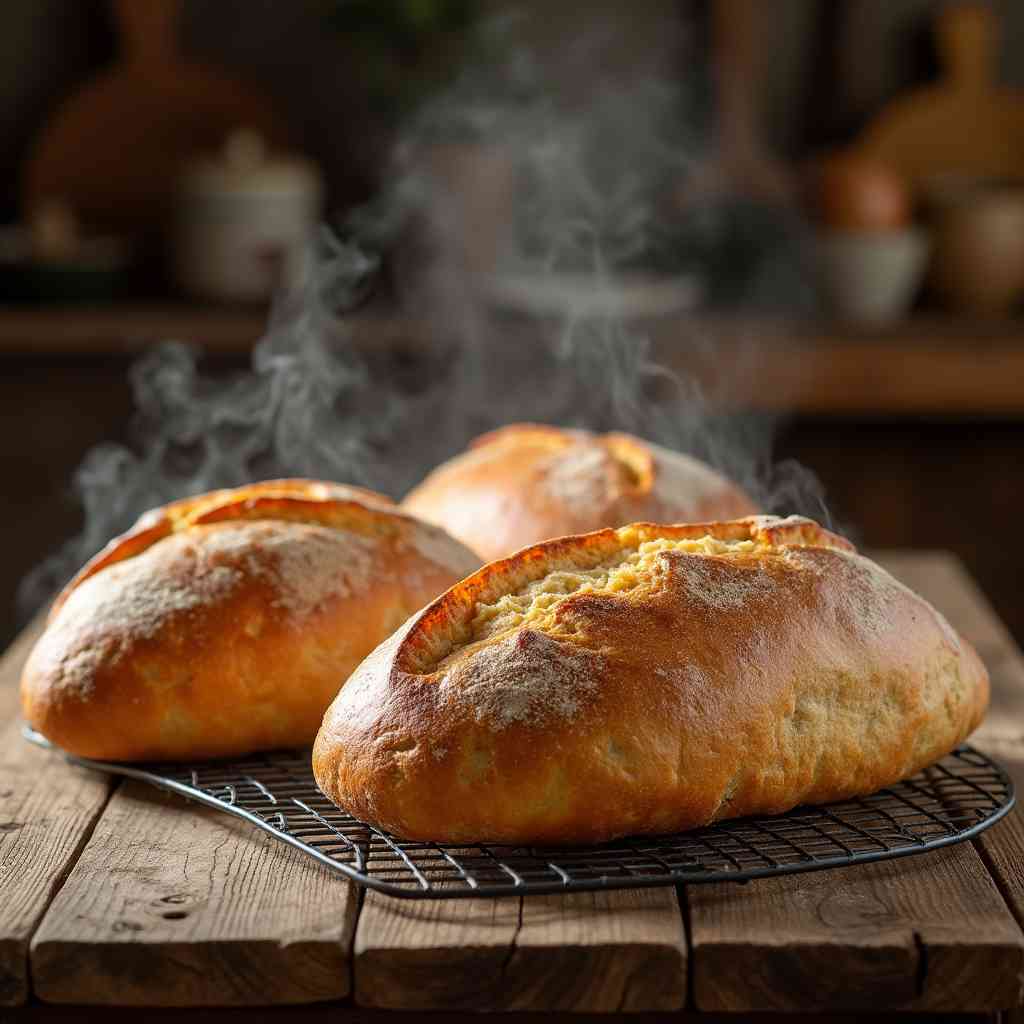This recipe is the heart and soul of Hutterite communal baking—a simple, warm loaf that speaks of history, togetherness, and honest ingredients. Imagine the scent of fresh bread filling a sunlit kitchen, hands dusted with flour, and neighbors gathering around long wooden tables. This isn’t just a recipe; it’s a tradition passed down through generations, one that unites community spirit with culinary art.
Jump To :
What Makes Hutterite Bread Recipe Special?
Hutterite bread stands apart thanks to its rustic simplicity and communal roots. Made in large batches, it uses just a handful of humble ingredients water, flour, yeast, salt, and often a touch of fat—to create a loaf that’s soft on the inside with a golden, crusty exterior.
Personally, I love how the slow rise develops depth of flavor without fuss. Try this trick: let the dough rest in a slightly cool spot overnight, and you’ll notice a richer aroma and lighter crumb the next day!
How to Make Hutterite Bread Recipe Step by Step

- Activate the yeast in warm water with a bit of sugar.
- Mix in fat and salt, then stir in flour until a dough forms.
- Knead until smooth and elastic.
- First rise until doubled.
- Shape loaves and second rise.
- Bake until golden and hollow-sounding.
Key Ingredients and Their Importance
- Warm Water (110 °F/43 °C): Awakens the yeast without killing it.
- Active Dry Yeast: The engine of rise; fresh yeast guarantees a fluffy loaf.
- Sugar: Feeds the yeast, improving rise and flavor.
- Fat (Oil or Lard): Adds tenderness and extends shelf life.
- Salt: Balances sweetness and strengthens the gluten network.
- Flour: Unbleached all-purpose or a mix with whole wheat brings structure and depth.

Hutterite Bread Recipe
- Total Time: 2 hours
- Yield: 2 loaves 1x
Description
A warm, simple, and traditional loaf rooted in Hutterite communal baking. This recipe blends humble ingredients with rich history to yield a soft interior and crusty exterior—perfect for gathering around the table.
Ingredients
- 2½ cups warm water (110 °F/43 °C)
- ¼ cup sugar
- 1½ tablespoons active dry yeast
- ¼ cup vegetable oil or melted lard
- 1 tablespoon salt
- 6 cups unbleached all-purpose flour (or a mix with whole wheat)
Instructions
- In a large bowl, combine warm water, sugar, and yeast. Stir gently and let sit for 5–10 minutes until foamy.
- Stir in oil or melted lard and salt.
- Add flour one cup at a time, stirring until dough pulls away from the bowl.
- Turn out onto a floured surface and knead for 8–10 minutes until smooth and elastic.
- Place dough in a greased bowl, cover, and let rise for 1 hour until doubled.
- Deflate dough, divide into two, shape into loaves, and place in greased 9×5″ pans.
- Cover and let rise 30–40 minutes, until just above the rim.
- Preheat oven to 350 °F (175 °C). Bake for 25–30 minutes until golden and hollow-sounding when tapped.
- Optional: Brush with melted butter for a softer crust.
Notes
For deeper flavor, allow the first rise overnight in the fridge. Add a pan of water in the oven for extra steam and a crispier crust. Use a kitchen scale for consistent flour measurements.
- Prep Time: 20 minutes
- Cook Time: 30 minutes
- Category: Bread
- Method: Baking
- Cuisine: Hutterite
Nutrition
- Serving Size: 1 slice
- Calories: 180
- Sugar: 2g
- Sodium: 250mg
- Fat: 3g
- Saturated Fat: 0.5g
- Unsaturated Fat: 2.5g
- Trans Fat: 0g
- Carbohydrates: 33g
- Fiber: 1g
- Protein: 5g
- Cholesterol: 0mg
Tips for the Best Hutterite Bread Recipe
- Slow Fermentation: For extra flavor, perform the first rise in the fridge overnight.
- Steam in Oven: Place a small pan of water on the oven floor to create steam; this yields a crispier crust.
- Consistent Temperature: Yeast loves consistency—avoid drafts and temperature swings.
- Weigh Your Flour: A kitchen scale ensures precision.
Recommended Tools
- Stand mixer with a dough hook (optional but handy)
- Digital kitchen scale
- Instant-read thermometer
- 9×5″ loaf pans (at least two)
- Cooling rack (for best texture)
How to Store Hutterite Bread Recipe for Freshness

- Short-Term (2–3 days): Keep at room temperature in a paper bag or loosely wrapped in a clean kitchen towel.
- Long-Term: Slice and freeze in airtight bags; toast slices straight from the freezer.
- Revive day-old bread by sprinkling with water and warming in a 300 °F oven for 5–7 minutes.
More Related Recipes & Articles
If you enjoyed this rustic loaf, you might love exploring:
- Our take on Hutterite Sausage Soup, a hearty pairing for fresh bread.
- The classic Hutterite Bun Recipe, perfect for picnics and potlucks.
- Follow our journey and daily inspirations on Medium.
- See mouthwatering photos and boards on Pinterest.
FAQs
Can I substitute instant yeast for active dry yeast?
Yes! Use 25% less instant yeast (about 1⅛ tbsp) and mix directly into the flour—no need to proof.
What if my dough doesn’t rise?
Check yeast freshness (expiration date) and water temperature (should be between 105–115 °F). Yeast dies above 130 °F.
Can I add whole grains?
Absolutely. Replace up to 25% of all-purpose flour with whole wheat or rye. You may need slightly more water.
How do I get a thinner crust?
Brush the loaves with butter post-bake or bake an extra minute with the oven door cracked.


Yummy
I love this bread, thank you